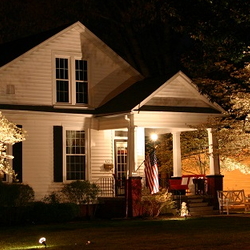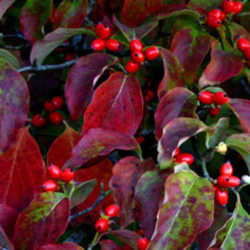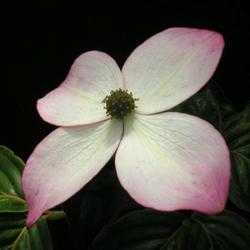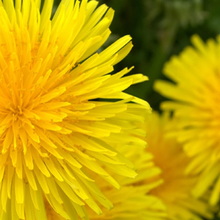(Editor's Note: This article was originally published on April 29, 2008.)
Dogwoods, Cornus florida, were first an understory tree that thrived on the edges of hardwood forests. They live in the semi-shady, acid soil conditions that distinguish such an environment. The trees have developed such an appeal that they have now become a popular landscape tree. They are commonly planted in rural yards and on urban lawns. The cheerful blossoms proclaim each year that Winter is over, and Spring is really here. It is beloved by many, and the fact that Missouri has voted the Dogwood their State Tree, and North Carolina their State Flower, says volumes. And Virginia loves the Dogwood so much that they have decreed that is both their State Tree and State Flower.

 People adore this tree, and many festivals and celebrations are held annually throughout the country with walking and driving trails for visitors to enjoy. There is a Lighted Dogwood Trail in the nearby town of Paducah, Kentucky every year. Since 1964, people have been encouraged to plant Dogwoods as a landscape tree. Each Spring, thousands enjoy the Dogwoods by night, as each home-owner spotlights their Dogwood trees, azaleas, and spring flowers in the evening. The route has evolved into a twelve mile tour that can be enjoyed by walking, bike, car, or city trolley. Many such activities are held across the country, and a simple internet search will no doubt locate one near you. It would be well worth the trip, as these trails and festivals are the source of much pride by the towns that host them
People adore this tree, and many festivals and celebrations are held annually throughout the country with walking and driving trails for visitors to enjoy. There is a Lighted Dogwood Trail in the nearby town of Paducah, Kentucky every year. Since 1964, people have been encouraged to plant Dogwoods as a landscape tree. Each Spring, thousands enjoy the Dogwoods by night, as each home-owner spotlights their Dogwood trees, azaleas, and spring flowers in the evening. The route has evolved into a twelve mile tour that can be enjoyed by walking, bike, car, or city trolley. Many such activities are held across the country, and a simple internet search will no doubt locate one near you. It would be well worth the trip, as these trails and festivals are the source of much pride by the towns that host them

 The night photography in this article is from the 2008 Paducah, Kentucky Dogwood Trail. The residents of historic Jefferson Street were pleased and excited by the lovely blossoms this year. Homeowner, Dianne Roberts was out checking on her Dogwoods, and enjoying the displays of her neighbors. She stated that the weather had been perfect this year, and the blooms were spectacular. After the late freeze in April 2007, and the resulting loss of the flowers, everyone was thrilled to have the mild temperatures this Spring. This was quite evident in the heavy traffic creeping slowly down the street. Cars had their windows down, and the occupants were enjoying the show, and the warm Spring air.
The night photography in this article is from the 2008 Paducah, Kentucky Dogwood Trail. The residents of historic Jefferson Street were pleased and excited by the lovely blossoms this year. Homeowner, Dianne Roberts was out checking on her Dogwoods, and enjoying the displays of her neighbors. She stated that the weather had been perfect this year, and the blooms were spectacular. After the late freeze in April 2007, and the resulting loss of the flowers, everyone was thrilled to have the mild temperatures this Spring. This was quite evident in the heavy traffic creeping slowly down the street. Cars had their windows down, and the occupants were enjoying the show, and the warm Spring air.

The Dogwood has a rich history other than a pretty landscape tree. The name Dogwood could be attributed to two different sources. Dogwood is a very hard and strong wood, and it was said that the term Dogwood could have easily evolved from the Celtic word dag, dagga, or dagwood over the years. The wooden dagge was simply a useful, pointed tool. The tight-grained wood contained no silica, so it was useful in cleaning small spaces that were easily scratched, such as in watches and jewelry. The wood is so hard that the finest weaving shuttles were made from it, and later, golf club heads. The botanical name Cornus reflects this quality, as it means horn, as in bull's horn.
Dogwood bark was also used as a mange treatment for dogs. The bark was boiled, and the dog was washed in the resulting liquid. Any medicinal properties that the bark or the tree actually has is minimal at best, and the practice of using the Dogwood for mange, seems to have resulted in the misconception that the name Dogwood meant that it was good for dogs.
 This tree is also the subject of an old Christian legend. According to the old stories, the Dogwood tree used to grow large and tall. It was compared in size and shape to an oak tree. At the time of the Crucifixion, it was said that wood from the Dogwood tree was selected to fashion the cross. This distressed and saddened the Dogwood tree so much that Jesus took pity on the tree, and promised that Dogwood trees will never again grow large enough to use the wood for a cross. It will be twisted and bent. The four petals of the flowers will form the shape of a cross, with two long petals and two short ones. In the center of each petal edge, a rusty nail mark will be cut, the bracts in the center will resemble a crown of thorns, with blood-red berries the result. As lovely as the story is, Dogwood trees did not grow in Palestine, and the legend can be traced to the early 20th century.
This tree is also the subject of an old Christian legend. According to the old stories, the Dogwood tree used to grow large and tall. It was compared in size and shape to an oak tree. At the time of the Crucifixion, it was said that wood from the Dogwood tree was selected to fashion the cross. This distressed and saddened the Dogwood tree so much that Jesus took pity on the tree, and promised that Dogwood trees will never again grow large enough to use the wood for a cross. It will be twisted and bent. The four petals of the flowers will form the shape of a cross, with two long petals and two short ones. In the center of each petal edge, a rusty nail mark will be cut, the bracts in the center will resemble a crown of thorns, with blood-red berries the result. As lovely as the story is, Dogwood trees did not grow in Palestine, and the legend can be traced to the early 20th century.
The Cherokee also had a legend concerning the Dogwoods. They believed that a tiny race of people lived in the forest and watched over them. They were called The Dogwood People. They taught them how to live in harmony with the land, and watched over the elderly and the infants. The Dogwood People believed in doing good deeds for others for the simple acts of kindness, not for personal gain, or to have someone indebted to you.
Dogwoods are a popular landscape tree and thrive in conditions that are similar to their woodland habitat. They are happiest when offered a bit of afternoon shade, in an area where there is a generous amount of moist, well drained soil. Do not situate them in deep shade or they will fail to produce many blooms. They need well drained soil with lots of organic matter. They will die if they have constantly "wet feet." Take care to protect the trunk from nicks and injuries as the Dogwood Borer will take the opportunity to enter the bark and can kill your tree. Anthracnose is a fungal disease that sometimes plagues Dogwood trees and can be identified by spots on the leaves and flowers. It can cause stem cankers also. If you suspect that your Dogwood tree has a pest problem, contact your County Extension Agent, and they will gladly help in identifying the problem.
These lovely little trees capture our hearts every Spring. We await the Dogwood blooms with anticipation and happiness. Dogwoods create a lovely show, regardless if they are a manicured lawn specimen, or the lacy wild trees peeking through the brand new green leaves of the forest. Their small size provides a variety of uses in the landscape, and their appeal extends throughout the year. They have outstanding Fall color, and the red berries create Winter interest until the wildlife eat them. Dogwoods simply give pleasure to all who see them. It's Spring, and it's time to enjoy the Dogwoods!

















